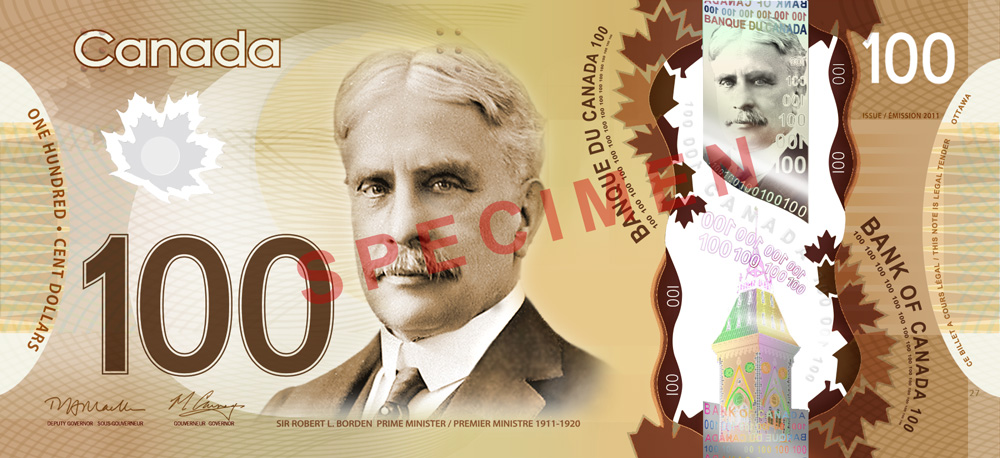The United States has launched a new $100 bill as of October 8, 2013, the first remake of the iconic banknote to be released since 1996. Since the $100 dollar bill is the U.S. banknote most frequently targeted by counterfeiters, the new design includes a number of complex security features designed to foil them.
Just how long counterfeiters will be kept at bay is, of course, impossible to predict, but Uncle Sam has certainly worked hard to make sure that this high-tech hundred will be more difficult for would-be counterfeit money printers to duplicate than were its predecessors.
A lesson from Canada?
In November of 2011, Canada released a  “counterfeit-proof” $100 bill. The high-tech polymer banknotes featured numerous anti-forgery features intended to foil counterfeiters. Specifically, the new notes included two transparent areas: the first extends from the top to the bottom of the notes and includes complex holographic features, and the second is in the shape of a maple leaf.
“counterfeit-proof” $100 bill. The high-tech polymer banknotes featured numerous anti-forgery features intended to foil counterfeiters. Specifically, the new notes included two transparent areas: the first extends from the top to the bottom of the notes and includes complex holographic features, and the second is in the shape of a maple leaf.
Then Bank of Canada governor Mark Carney said in a statement at the time the new notes were more secure, economic, and better for the environment. "These new and technically innovative notes will go a long way to deter the threat of counterfeiting in coming years," added RCMP Commissioner William Elliot in a media release at the time.
However, within 5 months, very high quality counterfeits began turning up all over the country. Asked how this could be the case, the BoC responded that the high security of the new notes might actually have been working against them, as retailers and other members of the public seemed to have lowered their guard and stopped scrutinizing bills with the same vigor as before.
The New US $100 Bill: Designed to Defy Duplication
Those who would be sorry to see the term “Benjamins” displaced from the Dictionary of American Slang will be glad to hear that Benjamin Franklin's familiar face is featured on the new $100 bill. However, he has had a bit of a makeover since the 1996 design, his portrait a bit more vibrant than it is on the older bill and no longer surrounded by an oval. Raised “intaglio” printing has been incorporated into the new design to make duplication more challenging, an addition that makes Franklin's shoulder rough to the touch. Philadelphia's Independence Hall still holds its traditional place on the back of the bill. However, the rear of the building is depicted, rather than the front view shown in the older design, a change meant to render images currently used to produce counterfeit money obsolete.
 The Philadelphia Liberty Bell is also incorporated into two key security features. A quill pen and copper-colored inkwell are displayed on the front of the new $100 bill to commemorate the signing of the Declaration of Independence. Inside the inkwell is a Liberty Bell that changes from copper-colored to green, depending upon the angle at which the bill is held, an effect that makes the bell seem to disappear and reappear. A blue, 3-D security ribbon woven into center of the bill is accented with tiny Liberty Bells and 100s that appear to move as it is tilted back and forth, an effect produced by millions of micro-lenses printed on the note.
The Philadelphia Liberty Bell is also incorporated into two key security features. A quill pen and copper-colored inkwell are displayed on the front of the new $100 bill to commemorate the signing of the Declaration of Independence. Inside the inkwell is a Liberty Bell that changes from copper-colored to green, depending upon the angle at which the bill is held, an effect that makes the bell seem to disappear and reappear. A blue, 3-D security ribbon woven into center of the bill is accented with tiny Liberty Bells and 100s that appear to move as it is tilted back and forth, an effect produced by millions of micro-lenses printed on the note.
The new design includes a watermark of Franklin's portrait, simplified as compared to the last version, that can be seen when the new banknote is held up to the light. Microprinting provides yet another layer of security meant to make the lives of counterfeit money printers more difficult, with tiny words printed along the note's borders, in Franklin's jacket collar, along the quill and within the space containing the watermark. Finally, an embedded thread, imprinted with USA and 100s in an alternating pattern is featured in this updated design, which is visible on both sides of the note and glows pink when placed under ultraviolet light.
So why is there such an intense focus on security in the new C-note design? According to the Federal Reserve, although the amount of counterfeit money in circulation at any given time is very small as compared to the overall value of legitimate banknotes, the problem is still a significant one. In 2012, approximately $80.7 million in counterfeit money was circulating within the U.S. economy, and about $14.5 million was in circulation overseas. Since the $100 bill is the U.S. currency note that sees the most widespread distribution overseas, it is also the most frequently duplicated by foreign counterfeiters, both independent and state sponsored.
This new and improved version of the $100 bill has been in the works for over a decade, with research and development beginning in 2003. These redesigned banknotes were originally slated to be released back in 2011, but a succession of production problems forced roll-out plans to be postponed for more than two years. These issues, according to the Federal Reserve, have finally been resolved and 3.5 billion of the new banknotes have been printed and distributed to banks throughout the U.S.
Since these printing problems were largely due to the complexity of updated security features, they certainly do not bode well for those who would attempt to print counterfeit money based on this new design. So, while anything is possible in today's world, chances are that these new security features will ensure that it takes quite some time for this newly released version of the $100 bill to be counterfeited.


